Eric Shawn Reports: The impact of Abu Sayyaf’s death on ISIS
Sayyaf was killed during a raid by U.S. Special Forces
Islamic State oil man Abu Sayyaf was riding high a year ago. With little industry experience, he had built a network of traders and wholesalers of Syrian oil that at one point helped triple energy revenues for his terrorist bosses.
His days carried challenges familiar to all oil executives—increasing production, improving client relations and dodging directives from headquarters. He also had duties unique to the extremist group, including approving expenses to cover the upkeep of slaves, rebuilding oil facilities damaged by U.S. airstrikes and counting towers of cash.
Last May, U.S. Special Forces killed Abu Sayyaf, a nom de guerre, at his compound in Syria’s Deir Ezzour province. The raid also captured a trove of proprietary data that explains how Islamic State became the world’s wealthiest terror group.
Documents reviewed by The Wall Street Journal describe the terror group’s construction of a multinational oil operation with help from officious terror-group executives obsessed with maximizing profits. They show how the organization deals with the Syrian regime, handles corruption allegations among top officials, and, most critically, how international coalition strikes have dented but not destroyed Islamic State’s income.
Defense Secretary Ash Carter called the May 16, 2015, raid a “significant blow” against Islamic State and heralded the death of Abu Sayyaf, the terror group’s No. 2 oil executive.

